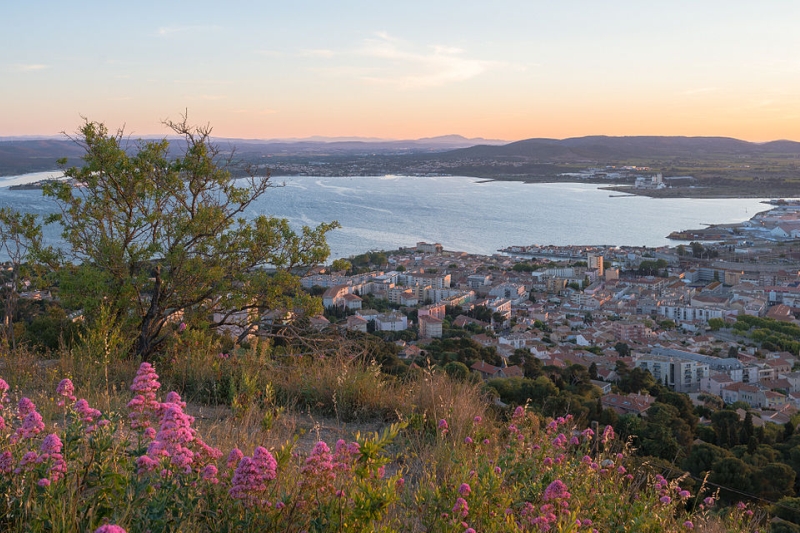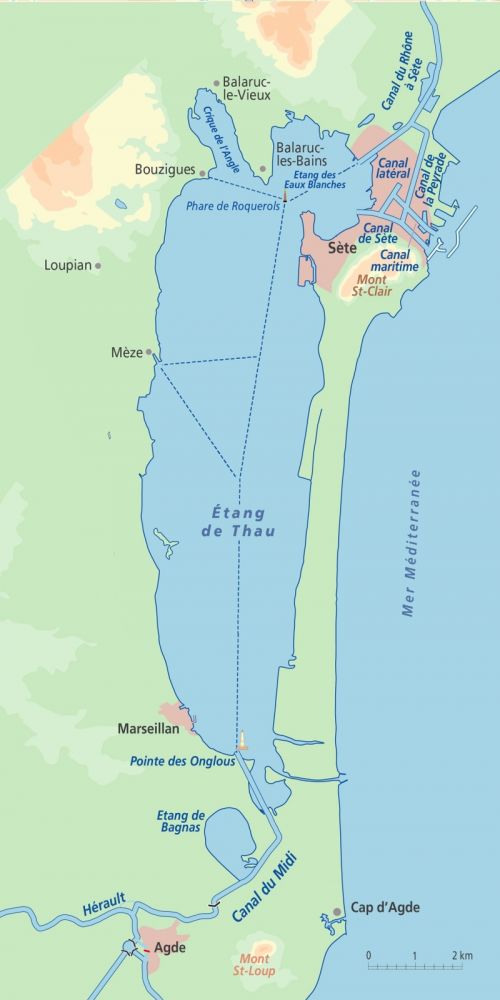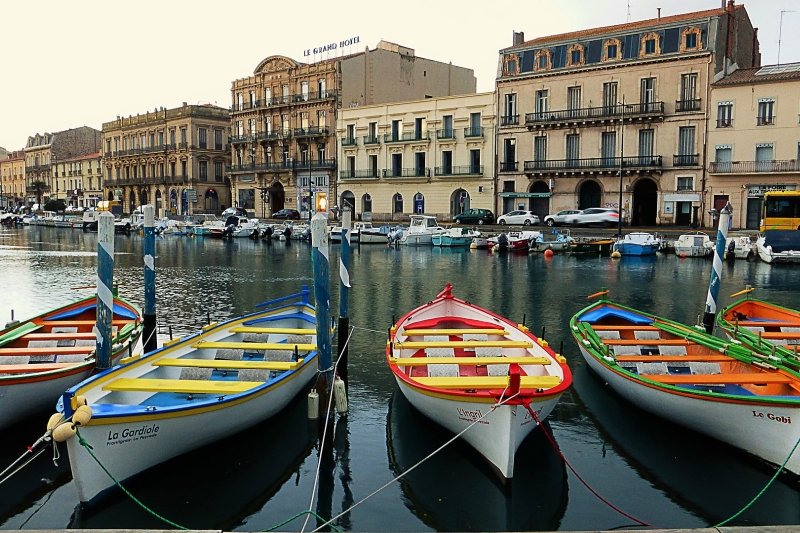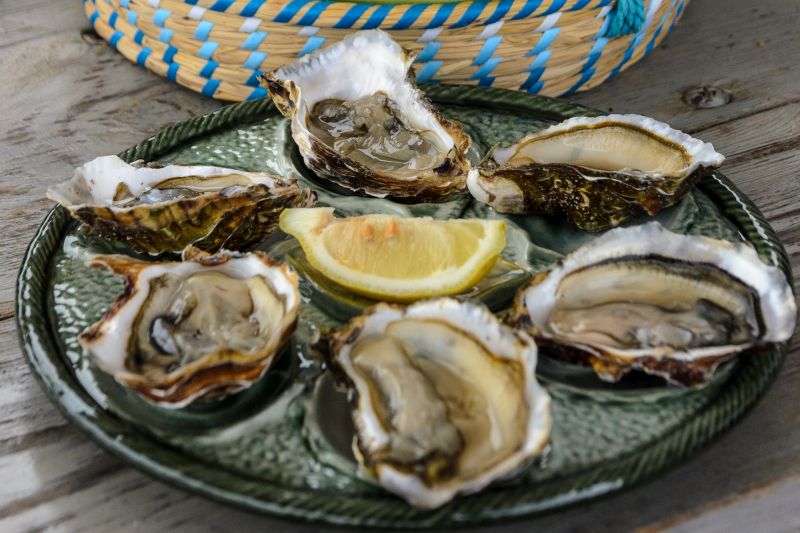Part 1: The Étang de Thau – An Overview
The Étang de Thau, sometimes known as the Bassin de Thau, is the largest of a collection of saltwater lagoons that span along the French coast from the Rhône River to the border with Spain.
The Étang de Thau is 21km long and 8km wide, it is the second largest lake in France. Until relatively recently, the lagoons from Marseillan to the Rhône were a continuous stretch of inland waterway and early settlers in the region described them as “une petite mer intérieure et tranquille”.
Linked by the Canal du Rhône à Sète to the Rhône and by the Canal du Midi to the Atlantic, the lagoon also has access to the Mediterranean at Sète. To the east, between Balaruc and Sète, the borders of the lagoon are largely industrial. The south bank is formed by the coastal strip from Sète to Cap d’Agde, at some points less than half a mile wide, whereas the northern bank has villages dedicated to fishing and the production of shellfish.
As the lagoon is open to the sea, it is well stocked with fish such as bream, croaker and seabass. Eighteen varieties of shellfish are also found in the lagoon, with the most economically important being oysters. 750 producers farm 2,750 oyster tables in the lagoon, and farm approximately 13,000 tonnes of oysters each year, providing approximately 8.5% of France’s consumption.
A flat variety, the oysters from the lagoon are relatively small and are marketed under the name “huîtres de Bouzigues” after the village where the oyster production started. The water of the Étang de Thau is graded A, so shellfish can be caught and consumed within minutes. In addition to oysters, some 3,000 tonnes of mussels are produced every year.
The Étang de Thau also provides a rich habitat for a variety of wildlife, notably birds including herons and pink flamingos.
Part 2: Towns & Villages
Balaruc-le-Vieux is an ancient bourg located at the north-eastern tip of the Étang de Thau. Nestled within its ramparts, the village retains its narrow and winding streets and features buildings dated to the time of Louis XIII, as well as vestiges of a medieval castle and the 14th century church of St-Maurice, built in both the Romanesque and Gothic styles.
The spa waters of Balaruc-les-Bains have long been associated with hydrotherapy. The Sanctuary of Neptune and the ancient Roman baths were excavated in the 1990s. Today the town’s economy is still based around hydrotherapy and is the premier spa in France by attendance. Its warm waters, which reach temperatures of 34- 40°C (93-104°F), are low in sodium chloride and rich in calcium and magnesium, whilst bringing benefits to joint problems such as rheumatism which are recognised by modern medicine.
The village also holds many architectural and archaeological gems. The 12th century chapel of Our Lady of the Water is built in the Romanesque style from blocks of limestone containing seashells. The remains of a religious building dedicated to the Roman god of the sea, Neptune, have been dated to the 1st – 3rd centuries AD.
Sète is located on the south-eastern edge of the Étang de Thau and is built around the prominent Mont St Clair. The town has a network of canals running through its centre, which link the lagoon with the Mediterranean. The town was built during the construction of the Canal du Midi, as a base to house the thousands of workers who were located nearby. There is a Grand Canal, alongside of which are Italianate houses in pastel colours, with wrought-iron balconies overlooking the canals and bridges. It was selected in 1666 as a trans-shipment port for the Canal du Midi.
The fishing harbour is lined with fishing boats on one side and with seafood restaurants on the other. One specialty of the town is the Tielle Sètoise, a small shortcrust pie with onions and chopped squid tentacles; another is Seiches à la Rouille – cuttlefish in a spicy garlic sauce. Sète is the largest French fishing port on the Mediterranean and the biggest commercial port in the south after Marseille. A car ferry leaves for Morocco daily.
Geographically it is located at the foot of Mont St-Clair, which long ago was a Mediterranean island. Those who walk up Mont St-Clair are rewarded with panoramic views of the sea and the glorious landscape of the Languedoc. Sète has long been associated with a fishing and sailing culture. Particularly fascinating in this ‘Venice of the Languedoc’ is the water jousting that dates back to the inauguration of Sète in 1666, which can be seen in all its flamboyance on August 25 (Saint Louis’ Day). Jousters with long poles stand in the bow of two rowing boats which approach eachother, the winner being the jouster who remains inside the boat the longest!
The town was the birthplace and home of George Brassens, France’s favourite troubadour. A small museum – to be visited with one’s ears as well as with one’s eyes – has been built to celebrate this famous singer, just opposite the graveyard where he is buried. Many restaurants and cafés are named after his songs. The residents of Sète, known as Sètoises, speak a French dialect – Occitan – with a strong, almost Spanish accent.
Situated on the northern edge of the Étang de Thau, Mèze has been an important port since its founding by the Phoenicians in the 6th century BC. During the Roman Empire, the town lay on the Via Domitia, the main route between Italy and Spain. The Romans brought wine and left a legacy of architecture, including two of the town’s churches, to the area.
The town shares with Bouzigues its historic role as the oyster capital of the Étang de Thau. Almost a third of its inhabitants depend on the fishing industry for their livelihood. The production of shellfish, especially oysters, has been the mainstay of the Mèze economy for almost a century and the whole Bassin de Thau area has built an international reputation for the quality of its seafood. As one of several centres for the mussel and oyster industry, Mèze has an aquaculture research centre called the station de lagunage, with information, films, photographs, and displays.
Located between Mèze and Bouzigues on the northern shore of the Étang de Thau, Loupian is an ancient town whose origins can be traced back to Roman times. South of the Via Domitia route linking Italy & Spain, recent archaeological digs have revealed the presence of an important Gallo-Roman villa dedicated to the production of wine and its export. The villa had an amphora production workshop and a port on the edge of the Étang de Thau. Its owners would have been incredibly wealthy for their time, namely due to the amount of beautiful mosaic floors discovered in the villa.
Not far from the villa and close to the 11th century church of St-Cécile, the remains of a large Paleo-Christian church have been discovered dating from the early 5th century, complete with a hexagonal baptismal font and several related rooms. A necropolis was also found in the grounds of this church. During the Middle Ages, the village moved closer: surrounded by ramparts, it featured the castle (today the town hall) and the Romanesque chapel of St-Hippolyte.
Bouzigues was first inhabited by outsiders of the church who were forced to live in troglodyte caves to repent for their sins. The village then grew into an agricultural centre before eventually finding its fame and fortune in the cooperage industry. In the 17th century, Bouzigues was divided between the Bishop of Agde and the de Bouzigues family.
At the beginning of the 20th century, the cultivation of oysters and mussels, distributed under the name “Bouzigues”, was developed. Today, this culture remains the driving force of the economy to which tourism in the area has been linked. A museum in the harbour offers visitors an insight into the fishing industry and the mussel and oyster farms that are so much a part of the landscape here, as well as the fishing activities and the natural environment of the Étang de Thau. Closer examination of the quayside shows that all the buildings are modern, unlike the surrounding medieval town. This is due to a dramatic event in August 1944 when one of the warehouses here which was being used as a munitions factory was blown up by the retreating German army, destroying the entire neighbourhood. Amazingly, although two French Resistance operatives were locked inside, they escaped before the building exploded.
Marseillan is an ancient settlement founded by the Greeks, on the western-most edge of the lagoon.
Ready to Explore the Étang de Thau?
Guests cruising the Canal du Midi aboard luxury hotel barges Anjodi, Enchante and Athos will have the opportunity to visit some the sites listed above. For more information on our itineraries and the rest of our collection of luxury hotel barge cruises, why not order a free copy of our brochure today or speak to a member of our team directly using our handy Contact Form.
 English
English
 Spanish
Spanish French
French German
German Norwegian
Norwegian Portuguese
Portuguese Swedish
Swedish Italian
Italian Russian
Russian Simplified Chinese
Simplified Chinese Japanese
Japanese





